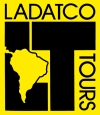

Destinations
Experiences
 |
L A
D A T C O T O U R
S |
 |
||||||||
| HOME | South America | Falkland Islands | Antarctica | Unique Destinations |
Unique Experiences |
Newsstand | ||||
|
Scalesia Lodge
About Scalesia Lodge About
|
|
ABOUT
ISABELA ISLAND
Attraction details - click here
ABOUT ISABELA ISLAND
The majority of Isabela residents make their living by fishing, farming, and tourism. In the 90s, development for tourism began. A small airport was completed in 1996 for inter-islands flights. The number of hotels, restaurants and bar grew since then. However, the town still retains its relaxed attitude in contrast to Puerto Ayora on Santa Cruz and Puerto Baquerizo Moreno on San Cristóbal The center of population is on the southern coast at Puerto Villamil. Villamil is probably one of the most beautiful townsite in Galapagos, with its long, white-sand, palm-lined beaches and several brackish-water lagoons frequented by pink flamingoes, common stilts, whimbrels, white-cheeked pintails, and gallinulesPuerto Villamil, complete with its white sand beaches, is consistently considered one of the most beautiful sites in the Galapagos Islands. Located just behind the town of Villamil are several brackish lagoons, where pink flamingos, common stilts, whimbrels, white-cheeked pintails, and gallinules can usually be seen. Between November and April each year, the lagoons serve as nesting areas, which makes the beaches and lagoons near Puerto Villamil some of the best viewing sites for migratory Galapagos Coastal Birds in the whole archipelago. In fact, some people also consider Puerto Villamil as one of the world’s most beautiful tropical destinations. The area is made up of volcanic soil left over from eruptions by Puerto Villamil’s five active volcanoes. Villamil still retains its local charm and has not yet been overrun by too many visitors.
HISTORY
Isabela Island was originally named Albemarle Island for the so named duke by Ambrose Cowley, one of the first men to ever set foot on the islands, in 1684. It was named after Queen Isabella of Spain. It is the largest of all the islands, with an area of 4,670 square kilometers (1,803 sq. mi), and length of 120 kilometers (74 mi),almost four times larger than Santa Cruz, the second largest of the archipelago. Tagus Cove on the northwestern side of the island provided a sheltered anchorage for pirates, buccaneers, whalers, and others for over 400 years. Darwin visited the place in 1835. Antonio Gil, a well-known Ecuadorian from Guayaquil, arrived in Galapagos in 1893 and after visiting the other islands, colonized southern Isabela, founding the town of Puerto Villamil on the southern coast and the town of Santo Tomás in the highlands. He named Villamil after the freedom fighter from Guayaquil, José de Villamil.The town of Puerto Villamil began as a lime production center. Santa Tomás was the center for a sulfur mine in the caldera of Sierra Negra Volcano and a nearby coffee plantation. Water limitations have always been a problem for the economic growth of the place. By 1974 there were nearly 450 residents on Isabela. This number has increased in each official census. Isabela was once used as an exile for prisone
GEOLOGY
Isabela Island is a hidden gem within a treasure. Shaped as a sea horse, Isabela is the largest island of the Galapagos and one of the younger ones. Isabela Island was formed about 1 million years ago by the joining of six shield volcanoes — from north to south — Ecuador, Wolf, Darwin, Alcedo, Sierra Negra, and Cerro Azul. All of the volcanoes still active except Ecuador. The western flanks of Ecuador Volcano have collapsed into the sea. Wolf Volcano, with an elevation of 1707 m (5600 ft.), is the highest point of Isabela Island and all Galapagos Islands. Two of the volcanoes, Ecuador and Wolf lie directly on the equator. Isabela is one of the more volcanically active islands. Eruptions have been recorded in the last fifty years for Wolf Volcano (1963 and 1982) (its last eruption occurred on the 25th of May 2015), Alcedo (1993), Sierra Negra (1963, 1979, and 2005), and Cerro Azul (1959, 1979, 1998, and 2008).The island is primarily noted for its geology, providing excellent examples of a geologic occurrence that created the Galapagos Islands including uplifts at Urvina Bay and the Bolivar Channel, tuff cones at Tagus Cove, and Pulmace on Alcedo and Sierra Negra, one of the most active volcanoes in the world and the second largest crater worldwide (11km diameter).
WILDLIFE
Isabela is also interesting for its flora and fauna. The young island does not follow the vegetation zones of the other islands. The relatively new lava fields and surrounding soils have not developed the sufficient nutrients required to support the varied life zones found on other islands. Another obvious difference occurs on Volcan Wolf and Cerro Azul; these volcanoes loft above the cloud cover and are arid on top.Isabela’s rich animal, bird, and marine life is beyond compare. Isabela is home to more wild tortoises than all the other islands. Isabela’s large size and notable topography created barriers for the slow-moving tortoises; apparently the creatures were unable to cross lava flows and other obstacles, causing several different sub-species of tortoise to develop. Today, tortoises roam free in the calderas of Alcedo, Wolf, Cerro Azul, Darwin and Sierra Negra.Introduced goats multiplied to over 100,000 but were eradicated by the Galapagos National Park Service and the Charles Darwin Foundation.
Other noted species include penguins, cormorants, marine iguanas, boobies, pelicans and Sally Lightfoot crabs abound. Galapagos land iguanas and Darwin’s finches, Galápagos hawks, Galápagos doves and very interesting lowland vegetation. The west coast of Isabela in the Bolivar Channel is the best place in Galapagos for viewing whales and dolphins.
In terms of wildlife, Isabela is home to the vast majority of all species found in the Galápagos. In the Puerto Villamil area you can find an abundance of ducks, finches, tropical birds, sea turtles, sea lions, marine iguanas, manta rays, sharks, eels and tropical fish.
Galapagos tortoises and land iguanas roam free around the Sierra Negra Volcano. Sally light foot crabs, hawks, owls, dolphins and whales, among other species, are often spotted there as well.